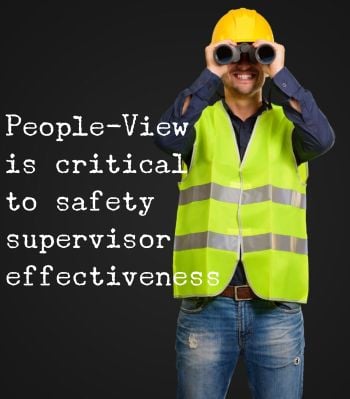People-View Is Critical To Safety Supervisor Effectiveness
People-View is how you talk about your crew to other supervisors or even your buddies behind the crew members' backs.
 “Keep it simple and as short as possible. These guys don’t want a lot of information and they won’t remember most of it anyway. And don’t make it too complex or it’ll go right over their heads. And don’t give them too many breaks or they’ll take their time coming back. Some of them might even take off from the meeting. You can’t trust them. They’ll take a shortcut if they can find one.”
“Keep it simple and as short as possible. These guys don’t want a lot of information and they won’t remember most of it anyway. And don’t make it too complex or it’ll go right over their heads. And don’t give them too many breaks or they’ll take their time coming back. Some of them might even take off from the meeting. You can’t trust them. They’ll take a shortcut if they can find one.”
Is that the people view for your crew? Is this how you talk about your crew to other supervisors or even your buddies behind the crew members' backs? Is that what you would say to an outside speaker or guest getting ready to address your people?
People view is how you view people - specifically your people, your co-workers. People view is the predetermined opinions you have about either the people you work with or those you do business with. That includes job site contractors and subcontractors.
Command-and-control is the default management style for supervisors who lack basic management skills. Chapter and verse from the rule book is easy because there is no arguing the rules. Supervisors, unskilled ones, are quick to write up job site infractions. Like a cop at the side of the highway, they get compliance through enforcement and threat. They view everyone under them as potential law-breakers. You can’t build a relationship of trust and respect with a people view like this.
If you think your people aren’t capable of grasping safety concepts, that will affect how you treat them. It will, more importantly, affect the relationship you have with them.
How do you view your crews and employees? Here are four self-test questions to help you identify your own people view:
1Do your people work under you or do they work with you? Here’s the difference. To have others work "under" you means that you subscribe to a hierarchical management philosophy. You believe that you are superior and you, as a supervisor, control your crew. You are higher up the ladder. However, working "with" you indicates that you subscribe to a teamwork and leadership philosophy. You believe that every member of the team is equally important. The teamwork philosophy works extremely well in building and reinforcing good crew-culture. It improves the relationship between supervisors and their crews. And if you want to have strong, cooperative safety perforamance, the relationship between supervisor and employee is key.
2Are yours good people wanting to do good work or are they grunts that you can’t trust to do safety right? What you go looking for is exactly what you will find. Your attitudes and opinions need support. You will skew your view of your people to support a preconceived attitude or opinion. You will look for evidence that you are right. If you believe that you can’t trust your people to do the right thing, you will find evidence. Even if it is from only one or two individuals, it will taint your view of everyone else. Conversely, good people doing good work and wanting to make good decisions will always provide evidence as well. And it will positively raise the perception of your crew. That, in turn, raises your expectations of their potential. And you will always find more evidence to support that point of view.
3Are you building them up and improving their potential daily or are you just trying to keep them in line and following the rules? Safety cops suck. Just ask your front-line people. They will tell you honestly that there is no fun in working with a safety cop just waiting for someone to mess up. “Gotcha” management is demoralizing. It sucks the motivation out of coming to work. No trust is built when this happens. No respect flows in either direction. You don’t trust them. They don’t trust you. So, look for ways to build their confidence instead of just correcting them. Look for ways to thank them instead of condemn them. Look for ways to engage instead of punish. Look for ways to raise their potential instead of squash their spirit.
4Do you move their suggestions and ideas upstairs or do you dismiss their ideas? In other words, are you an advocate for your crew? Do you have their backs? More importantly, do they have yours? If you believe that your good people have good ideas, they will share those ideas with you. Advancing a good idea from your crew can make you look like a hero upstairs (provided you give the full credit to the front-line person whose idea it is). You will also be a hero to your crew by advocating on their behalf. You build trust by being a trusted advocate for their wellbeing. Good people flourish when led by good people.
Be honest with yourself. If you answered “sometimes” on the negative side of any of the people view questions, study the instances when you do it. Be clear about your triggers to go to the negative side. Then ask if there’s a more effective way to create a win-win for everyone.
Kevin Burns is a management consultant, safety speaker and author of "The Perfect Safety Meeting" and "Running With Scissors - 10 Reasons To Invest in Safety In Slow Times." He is an expert in how to get through to people and believes that the best place to work is always the safest place to work. Kevin helps organizations integrate caring for and valuing employees through their safety programs.
(c) Can Stock Photo


